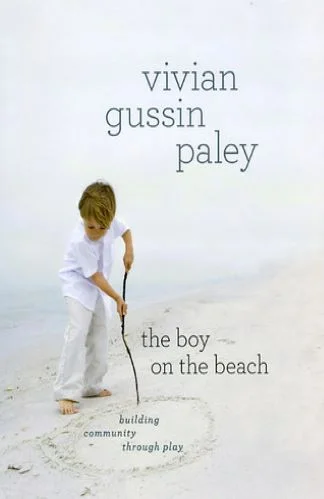
The Boy on the Beach
by Vivian Gussin Paley
Review by Patsy Cooper
Patsy Cooper is an author, Director of Early Childhood Education at Queens, and founding Director of the School Literacy and Culture Project at Rice University, which works with teachers implementing Paley’s work.
Book No: 13 – 1st published: 2010
One role is as good as another, so long as you can be inside the story and become necessary to the group.
Written more than 30 years after her first book, The Boy on the Beach is Vivian Gussin Paley’s last book-length publication. The good news is Paley once again manages to surprise us with original insights into children’s imaginative thinking and play.
The book includes chapters on the familiar and welcome territory of young children at play. However, interspersed throughout are six chapters dedicated solely to an exchange of letters Paley has with a Taiwanese teacher friend. The prominence and status of another teacher’s voice in The Boy on the Beach serves as a robust invitation from Paley to work alongside her in, what turns out to be, her culminating investigation into the lives of young children .
Yu-ching Huang is Paley’s classroom correspondent, her ‘pen pal’. They first met in Taipei when Yu-ching invited Paley to demonstrate Storytelling and Story Acting. Yu-ching, like so many of Paley’s readers and researchers world-wide, adopted the approach into her classroom curriculum and never looked back. The book’s epigraph actually turns over the book’s key message to Yu-ching, and, in doing so, elevates the status of teachers everywhere.
DEAR YU-CHING: I have a name for us. We are anecdotists. The dictionary says this is someone who collects and tells little stories. Of course, our stories are all about little children, but I think the name fits. Vivian
DEAR VIVIAN: Do anecdotists ask why? If so, then I agree to be called an anecdotist. Yu-ching
And with this, we are off, called to ask why, not in the abstract, but at the ground level. Paley wants to know: Why do children in Wisconsin borrow the winds and rain of New Orleans’ Hurricane Katrina? Why must Stanley play the wolf? Yu-ching wants to know: Why does Ling tell stories about a yellow jacket who stings everyone and then moves on to ones about a beautiful butterfly? Interestingly, from two sides of the globe both find a need to ask why girls must become kitties before they can slip off their mama’s laps and join the play? And more. Why do children do what they do?
But, then, in an unexpected twist, and further proof of her influence on Paley’s thinking, Yu-ching revises the proposition. ‘Actually, I think the children are the anecdotists,’ she writes. She continues, they tell stories to understand, ‘to practice, their own thoughts.’ From this perspective, Paley’s thirteen attempts to be a reliable narrator of young children’s lives comes full circle. The scenes of early childhood we witness, or even participate in, are not, legitimately, teachers’ stories. They are only the stories we borrow from the children.
Yu-ching and Paley are clearly in agreement that the teacher’s job is not only to make room in the curriculum for children to practice their thoughts through anecdotal storytelling, but to support the children’s interpretation with observation, comment, or, simply, appreciation.
As for what new things The Boy on the Beach has to teach us about how children think and what they think about, I found myself circling back to her exchange with Yu-ching around the concept of ‘creative kindness,’ the way in which groups of children will change their play to accommodate the outsider.
In this book, Paley explores how the children accommodate Stanley in Mrs. Olsen’s kindergarten by allowing him to be the wolf. But Yu-ching tightens up Paley’s definition: ‘Creative kindness is good,’ she agrees, but ‘to let someone be necessary is creative kindness.’
This nuance is the book’s moral center: Why would we ever permit children to become unnecessary in school?
Finally, unlike some of Paley’s earlier books which proffer more radical ideas of teaching and inclusion, The Boy on the Beach is a gentle reminder that, if, indeed, children fear loneliness in school, ‘loneliness is impossible’ when anecdotes and stories draw connections between children and teachers, between children and each other.











